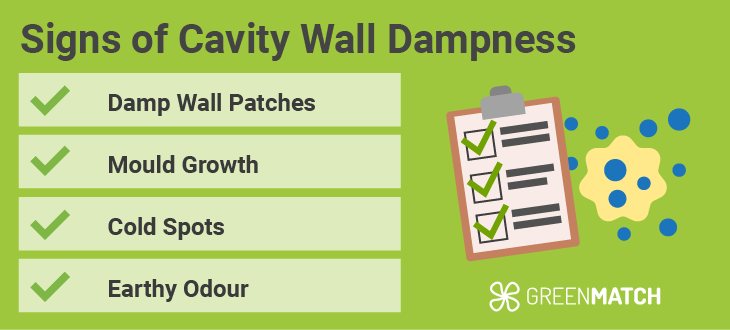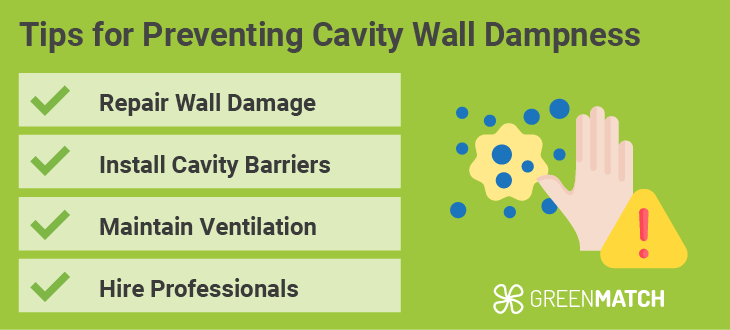Answer these simple questions and we will find you the BEST prices
Which type of solar quotes do you need?
It only takes 30 seconds
100% free with no obligation

Get Free quotes from insulation specialists near you

Save money by comparing quotes and choosing the most competitive offer

The service is 100% free and with no obligation
- GreenMatch
- Insulation
- Wall Insulation
- Cavity Wall Insulation
- Cavity Wall Insulation Damp
Does Cavity Wall Insulation Cause Damp? A UK Guide


- Cavity wall insulation in a detached home can save up to £405 in annual energy bills.
- Poorly installed cavity wall insulation runs the risk of collecting moisture and mould.
- There are several tips and proactive actions you can take to keep your cavity wall insulation healthy and functional.
Cavity walls are a popular build throughout the UK, making up around 71% of all properties throughout the nation. However, nearly 6.1 million cavity wall properties still lack adequate insulation for walls, leading to sky-high energy bills, damp homes, and huge carbon footprints.
Cavity wall insulation is a quick, non-invasive, and highly effective method of insulating your walls, but like any insulation job, there are several proactive measures you can take to avoid problems such as dampness and mould growth. Yet the real question is, can cavity wall insulation cause damp?
This complete GreenMatch UK guide will provide everything you need to make the right decision on your cavity wall insulation, including potential problems, solutions, and insider tips on how to get the best out of your cavity wall insulation.
Ready to get your cavity walls insulated? Let GreenMatch UK be your one-stop solution to finding the most professional installers at the best bargains. Instead of spending endless hours on the web, just spend 30 seconds filling out our simple online form, and we’ll deliver you up to 3 free home-tailored quotes. No charges, no obligations. Click below to begin!
- Describe your needs
- Get free quotes
- Choose the best offer
It only takes 30 seconds



Does cavity wall insulation cause damp?
Cavity wall insulation does not cause dampness itself, but damaged cavity walls or a poor installation job certainly can. In most cases, cavity walls with cracks and gaps in the outer brickwork can invite moisture to build up in the cavity space.
Other factors such as loose insulation, poor ventilation, or even wind-driven rain can all contribute to moisture buildup in the cavity space.
Cavity wall insulation causing damp only happens if it is poorly installed. As cavity insulation bridges the gap between the outer and inner walls of your home, it makes it very easy for moisture to travel from the outer wall to the inner wall if compromised.
Luckily, a professional installation and some proactive steps can help avoid this problem.
How may cavity wall insulation cause damp
Whilst cavity wall insulation itself won’t cause dampness issues, even the best cavity wall insulation can benefit from knowing how dampness issues can arise. The key problems are:
- Poor condition of external walls
- Pre-existing dampness issues
- Faulty installation
- House location and wind-driven rain
Having a good understanding of the potential pitfalls associated with cavity wall insulation and damp will help you proactively plan and avoid any issues from arising. It can also give you a better idea of whether cavity wall insulation is suitable for your property.
External wall condition
The most common cause of cavity wall insulation damp for homes is the poor condition of cavity walls. More common in older properties, cavity walls with cracks, gaps, and loose bricks on the outer wall are improperly sealed, and at risk of collecting moisture.
When you install cavity wall insulation, it bridges the gap between the outer and inner walls. If the outer wall is porous, moisture can travel through the insulation material and collect on the inner wall, leading to dampness in your home.
That’s why it's important to conduct a wall assessment to ensure your cavity walls are in the necessary conditions to house insulation.
Pre-existing damp problems
Similar to the case of poor-condition cavity walls, there may be outstanding issues that, without repairing, are also causing dampness even before you get cavity insulation.
One common issue can be a lack of proper ventilation. While it’s true that the cavity space should be sealed shut, an installer needs to account for draining rainwater in case it gets into the cavity space. For this, some degree of ventilation needs to be considered.
Another common issue can be an unclean cavity. If there is outdated insulation or debris left in the cavity space, this can act as a bridge that transfers moisture from the outer wall to the inner wall. Before you add any new insulation, it’s important to make sure your cavity space is clean.
Poor installation
Poor workmanship and a shabby installation job can be the difference between a warm cosy home, and a financial trainwreck.
Unprofessional installers may not take into account existing wall damage, repairs, or ventilation when installing the cavity wall insulation. To avoid this, work with a professional installer.
A helpful tip, cavity wall insulation cannot be done DIY. It requires a professional with training and access to industry-standard equipment. To ensure you get the best quality of work, aim to hire a CIGA-certified installer. The Cavity Insulation Guarantee Agency (CIGA) even provides up to 25-year guarantees on cavity wall insulation jobs.
Wind-driven rain
The geographic location of your home and its exposure to wind and rain can play a huge role in whether cavity wall insulation is the right choice for you.
Simply put, when the cavity space is filled with insulation, it bridges the gap between the outer and inner walls. Unsheltered homes frequently exposed to wind-driven rain will have soaked outer walls. This moisture can travel through the insulation to your inner walls, causing a damp home environment.
A study backed by the UK Government, carried out by UCL and BRE looked into areas of the UK that have high exposure to wind-driven rain. The study splits the UK into 4 zones of rainfall and considers areas of high exposure to be zone 3 or above.

Therefore, homes classified as zone 3 or 4 are not recommended to get cavity wall insulation, unless your home is in a properly sheltered area. Cavity wall insulation alternative approaches, like internal wall insulation or external wall insulation, may be more suitable in this case.
What are the signs of dampness in cavity wall insulation?

Before a problem gets out of hand, there will be telltale signs of moisture and dampness in your cavity walls. By noticing these issues in their earlier stages, you win the chance to avoid hefty repair bills down the line. Here are some things to look out for:
- Damp wall patches: You may notice moist areas of your inner wall that probably indicate that moisture has permeated through your outer wall and insulation material, and reached the inner wall of your home.
- Mould growth: If your home is not susceptible to mould, yet suddenly you notice growths more often, it can indicate that the dampness of your home has increased. Mould dislikes dry climates and will not be able to grow without adequate moisture.
- Cold spots: If you feel a little colder in some parts of your house than others, you should check your walls. Noticing cold spots doesn’t mean your insulation is damp, but can indicate that it has begun to clump, leaving sections of your wall uninsulated. These gaps that form, however, can indeed collect moisture in the long run.
- Earthy odour: If you notice that your home has a moist, earthy smell to it, this might indicate that there is moisture and mould growth within your cavity walls. While it may not be easy to spot in the home, this can indicate the need to get your cavity walls assessed by a professional.
Are you noticing any of these telltale signs of failed cavity wall insulation? Don’t know how to check cavity wall insulation? It’s best to get your cavity wall insulation professionally assessed to determine whether it’s been compromised or not. Dealing with these problems proactively can help save you hefty repair bills in the long term.
How to fix dampness caused by cavity wall insulation?
If your cavity walls are suffering from dampness issues, it’s not the end of the world! Thankfully there are several ways these problems can be solved with long-term benefits.
- Assess your walls: If you suspect that you have compromised cavity wall insulation, you can arrange an assessment by an installer to identify any issues that may be taking place. This is the first step to fixing any problem.
- Claim your guarantee: If your cavity wall insulation was carried out by a CIGA-certified installer, then you are entitled to a 25-year guarantee on the job! Contact your installer to assess the issues, or contact CIGA directly.
- Replace insulation: Once your cavity wall issues have been resolved and your walls prepped, you can consider installing new cavity wall insulation. There are several great options on the market with unique properties. For example, polystyrene beads are entirely moisture and mould-resistant.
It’s good to know that cavity wall insulation cannot be handled DIY and that a professional is needed. Choosing the right installer can be the difference between decades of comfort, or endless hefty repair bills.
Tips for preventing cavity wall insulation damp

Knowing how to identify and solve cavity wall dampness issues proactively will help make sure your home environment and insulation stay healthy and functional. Taking into account the most common cavity wall insulation problems, here are some tips on how to solve them:
- Repair wall damage: Any cracks, gaps, and openings on your outer wall will inevitably compromise the function of your cavity wall insulation. Having these sealed will help protect the insulation material within, and stop moisture from entering the cavity.
- Install cavity barriers: While these handy barriers are primarily meant to stop the potential spread of fire through cavity walls, they can also help better seal off frame openings, such as doors, windows and other gaps.
- Maintain ventilation: When assessing your cavity walls, or getting insulation installed, make sure that there is adequate space for ventilation and draining, should moisture ever enter your cavity space. This can help prolong the life of your insulation.
- Hire professionals: Perhaps the most important point is to not work with unaccredited installers just because they are cheap. Working with a professional CIGA-certified installer will make sure you get quality workmanship, and a 25-year guarantee on your insulation job should any problems arise.
While it may sound easy, finding a professional installer at an affordable price can be quite a challenge. Most of us don’t have endless hours to spend scouring the web and scheduling phone calls with potential contractors, but GreenMatch UK can help you out!
Through our nationwide network of trusted professionals, we can deliver you up to 3 free home-tailored quotes at competitive prices. Our services are completely free and without obligations. Simply spend 30 seconds filling out our form and let the bargains come to you. Click below to begin!
- Describe your needs
- Get free quotes
- Choose the best offer
It only takes 30 seconds



FAQ
Cavity wall insulation will not make your house damp if it is installed correctly, and your cavity walls are in healthy condition. It’s important to work with a professional accredited installer to make sure you receive quality workmanship and reduce your risk of home dampness.
Dampness permeation through a cavity wall often occurs through openings in your outer wall. Any cracks and gaps on your brickwork need to be sealed to prevent moisture from entering the cavity space. Having a home that is at risk of wind-driven rain can also lead to dampness from overexposing your outer walls to moisture.
If you notice any of the telltale signs of dampness in your home, such as damp wall patches, mould growth, or cold spots, it’s best to get your cavity wall insulation checked. If it’s collected moisture and is in poor shape, you will benefit from replacing your cavity wall insulation.
Depending on the problem at hand, you can fix dampness caused by cavity wall insulation by working with a professional installer. Any wall damage must be assessed and fixed, old compromised insulation removed, and new insulation added properly. Accounting for ventilation and drainage can also help prolong the life of your cavity wall insulation.
You will likely notice signs of wet cavity wall insulation by observing your home environment and inner walls. If your energy bills are higher, you have cold spots in your home, wet patches on your wall, or an earth odour in your living space, chances are you have moisture issues in your cavity walls.

Akif is a copywriter at GreenMatch since 2023. With a keen interest in community sustainability, green solutions and the role of digital media in identifying climate trends, he aims to hone in on his background in International Studies and Digital Media to provide a multidisciplinary approach to written content rooted in credible research and accuracy.
We strive to connect our customers with the right product and supplier. Would you like to be part of GreenMatch?

